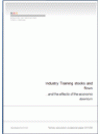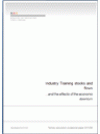This paper examines the new starts, terminations and other exits in industry training, looking at the relationship between industry training take-up and the business cycle. Because participants in industry training must have jobs to enter training, and because industry shares some of the cost of training, it is expected that flows of learners into, within, and out of industry training will match changes in the business cycle.
Key Results
- There were large increases in government funding for industry training between 2003 and 2007 but the number of new learners has not increased to the same extent. Much of the increased funding went into retaining existing trainees.
- Industry training and Modern Apprenticeship new starts dropped away in 2009. This followed a period of stability in levels of new entrants to industry training, and growth in levels of new entrants to Modern Apprenticeships.
- In 2009, withdrawals from both programmes increased, against the trend of previous years.
- As a percentage of total participants, withdrawals were greater for industry training than for Modern Apprenticeships. New starts fell more sharply for Modern Apprenticeships than for industry training.
- These findings coincide with a downturn across most industries in New Zealand during 2009. Trainee numbers in some industries, such as building and construction, forestry, furniture and fishing, were clearly adversely affected by this downturn.
- Not all ITOs were affected in the same way, with some seeing net growth against the overall trend. Real estate is the most obvious example. Other ITOs continued to sign up new learners. However, these new starts were more likely to be older, more experienced workers.
- Younger people were more affected than older people by the reduction of new starts, as were Māori and Pasifika people. This is probably a reflection of the demographic make-up of the industries most affected by the downturn


